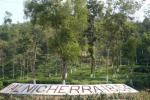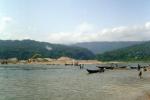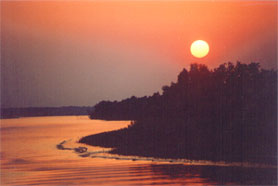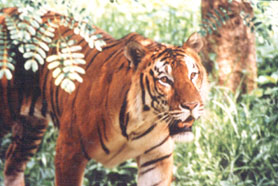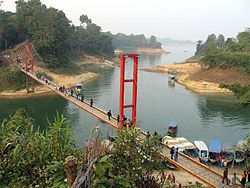
Travel News in Bangladesh
Wednesday, March 06, 2013
Tuesday, March 05, 2013
Jamuna Bridge


Jamuna Bridge is the largest Bridge in Bangladesh and the 11th longest bridge in the world.It is constructed over the river jamuna, mightiest of the three major rivers of Bangladesh, and fifth largest in the world in terms of volumetric discharge. The bridge established a strategic link between the eastern and western parts of Bangladesh. It generates multifarious benefits for the people and especially,promotes inter-regional trade in the country. Apart from quick movement of goods and passenger traffic by road and rail, it facilitated transmission of electricity and natural gas, and integration of telecommunication links.
The bridge was constructed at a cost of $962 million. The cost of construction was shared by IDA, ADB, OECF of Japan, and the government of Bangladesh. Of the total, IDA, ADB and OECF supplied 22% each, and the remaining 34% was borne by Bangladesh. The components of the project's cost were: bridge and viaducts - $269 million (28%); river training works - $323 million (35%); roads and embankments - $71 million (7%); consultancy - $33 million (3%); land, resettlement and environment - $67 million (7%); establishment - $13 million (1%) and others - $186 million (19%).
Considering the fact that the width of the main channel does not exceed 3.5 km, and after making allowances for Floods, a bridge length of 5 km was considered adequate. In October 1995, one year after the commencement of physical work of the bridge, a bridge length of 4.8 km, instead of a flood-width of the river at 14 km, was finalised. This narrowing was essential to keep the overall project cost within economic viability. It has, however, required considerable river training work to keep the river under the bridge.
To withstand predicted scourge and possible EarthQuack, the
bridge is supported on 80-85 m long and 2.5 m and 3.15 m diameter steel piles,
which were driven by powerful (240-ton) hydraulic hammer. The superstructure of
the bridge is pre-cast segments erected by the balanced cantilever method.
Basic features of the bridge are: length (main part) - 4.8 km; width - 18.5
metre; spans - 49; deck segments - 1263; piles - 121; piers - 50; road lanes -
4; railway tracks - 2.
Sunday, March 03, 2013
Niribili
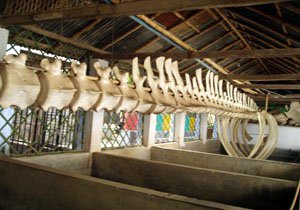
 A confirmed bachelor, Sultan settled down in an abandoned building in Narail overlooking the river Chitra, where he lived ever since with an adopted family and pets of his own including dogs, mongoose and monkeys. Sultan would later build a mini-zoo near his home. Apart from occasional visits to Dhaka, the capital, Sultan only once left Narail for any substantial period of time. He became interested in a ruined house in Sonargaon, pretty much like his own home in Narail, and lived there for a period.
A confirmed bachelor, Sultan settled down in an abandoned building in Narail overlooking the river Chitra, where he lived ever since with an adopted family and pets of his own including dogs, mongoose and monkeys. Sultan would later build a mini-zoo near his home. Apart from occasional visits to Dhaka, the capital, Sultan only once left Narail for any substantial period of time. He became interested in a ruined house in Sonargaon, pretty much like his own home in Narail, and lived there for a period.Sunday, February 10, 2013
Sylhet
Jaflong: This natural scenic spot amidst tea gardens and
hills is located about 60km from Sylhet city and can easily be reached by local
buses and privately hired car. It is a border area between Bangladesh and the
Indian state Meghalaya. Height wise it is just below the mountain range.
Tourist attractions here includes Collection of Rolling Stones, Colorful
tribal (Khasia) Life, Khasia King’s Palace, Mountain Streams, Tea
Gardens,Orange Groves, Betel Leaf &, Areca Nut Gardens and the Local
Market.
Jaintapur: Famous for its megalithic archaeological
ruinsand only 5 km. from Jaflong. It is a beautiful spot amidst tea gardens.
Once this was the capital of Jainta Kingdom at 18th century. The
ruined palace of the Kings is adjacent to the local market, however, big number
of tourists visit here due to the historical background of Jainta Kingdom.
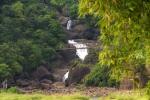 Lala Khal: This wide canal is a common tourist
destination as the water here appears in different colors at different points.
Lala Khal: This wide canal is a common tourist
destination as the water here appears in different colors at different points.
The Museum of Raja: Located at the heart of Sylhet, the museum's mission is to preserve and share the rich history of the great Mystic poet Dewan Hasan Raja.
Temple of Sri Chaittayana
Dev: This 500 year old famous temple is located about 45 km
southeast from Sylhet town. Yearly fair is organized on the full moon day of
the Bangla month Falgun. Hundreds and thousands of devotees from home and abroad
attend this colorful fair.
Tilagarh EcoPark: Located about 6 km from Sylhet city. It
is a tropical evergreen and semi-evergreen bio-geographic zone.Shrine of Hajrat
Shah Jalal and Hajrat Shah Poran: Shrine of these two renowned sufis are
located close to sylhet town.
 Tamabil: A border crossing between India and
Bangladesh located 55km north of Sylhet. The border formalities being messy,
foreigners rarely cross here. But scenery starting from past the border and up
to Shillong in India is spectacular.
Tamabil: A border crossing between India and
Bangladesh located 55km north of Sylhet. The border formalities being messy,
foreigners rarely cross here. But scenery starting from past the border and up
to Shillong in India is spectacular.
Tribal Village: Several aboriginal tribes live high
up on the hills and practice age-old rituals, customs and traditions. With
prior permissions it is possible to visit them during yearly festival periods.
The Manipuri Tribe is famous for dancing, singing and traditional weaving
and the Khashia tribe is famous for betel leaf cultivation.
Malinicherra
Tea Garden: A very old tea garden established during 1854
 Tamabil: A border crossing between India and
Bangladesh located 55km north of Sylhet. The border formalities being messy,
foreigners rarely cross here. But scenery starting from past the border and up
to Shillong in India is spectacular.
Tamabil: A border crossing between India and
Bangladesh located 55km north of Sylhet. The border formalities being messy,
foreigners rarely cross here. But scenery starting from past the border and up
to Shillong in India is spectacular.Rajshahi
Rajshahi division is the North-western part of our country.
This division is completely separated by Ganges - Brahmaputra Rivers from the
rest of the country. With an area of 34,513 square kilometer, it is bounded by
West Bengal of India on the north, Khulna and Dhaka divisions on the south,
Assam and Meghalaya state of India and Dhaka division on the east and West
Bengal of India on the west.
Total population of 29,992,955 is divided into male 50.80% and female 49.20%. Muslim 86.84%; Hindu 11.09%, Christian 1.17%, Buddhist 0.23% and others 0.67%.
Rajshahi division is famous for its Mango and Rice production. It also produces Wheat, sugarcane, oil seed, onion, garlic, potato, banana, betel leaf, mulberry plant, jackfruit, litchi, berry, coconut, and papaya. Numerous archaeological sites in the division made it an attractive destination for tourists.
This division is suitable for Archaeology tour, Agriculture tour, Photography Tour, Fruit Tour, Fishing Tour, Culture Tour, and Monsoon Tour.
Rajshahi is accessible by road, Air and Train.
Total population of 29,992,955 is divided into male 50.80% and female 49.20%. Muslim 86.84%; Hindu 11.09%, Christian 1.17%, Buddhist 0.23% and others 0.67%.
Rajshahi division is famous for its Mango and Rice production. It also produces Wheat, sugarcane, oil seed, onion, garlic, potato, banana, betel leaf, mulberry plant, jackfruit, litchi, berry, coconut, and papaya. Numerous archaeological sites in the division made it an attractive destination for tourists.
This division is suitable for Archaeology tour, Agriculture tour, Photography Tour, Fruit Tour, Fishing Tour, Culture Tour, and Monsoon Tour.
Rajshahi is accessible by road, Air and Train.
Saturday, February 09, 2013
Paharpur
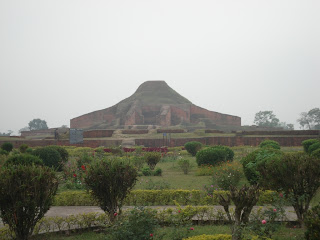
Paharpur is a small village 5 km. west of Jamalganj in the greater Rajshahi district where the remains of the most important and the largest known monastery south of the Himalayas has been excavated. This 7th century archaeological find covers approximately an area of 27acres of land. The entire establishment, occupying a quadrangular court, measuring more than 900 ft. externally on each side, has high enclosure- walls about 16 ft. in thickness and from 12 ft. to 15 ft. height. With elaborate gateway complex on the north, there are 45 cells on the north and 44 in each of the other three sides with a total number of 177 rooms. The architecture of the pyramidal cruciform temple is profoundly influenced by those of South-East Asia, especially Myanmar and Java. A small site-Museum built in 1956-57 houses the representative collection of objects recovered from the area.The excavated findings have also been preserved at theVarendra Research Museum at Rajshahi.The antiquities of the museum include terracotta plaques, images of different gods and goddesses, potteries, coins, inscriptions, ornamental bricks and other minor clay objects.
Dhaka
The capital city of Dhaka, the heart of Bangladesh, is a colorful and thriving metropolis with about 14 million people. Known as the the city of mosques, muslin and colorful rickshaws, Dhaka has attracted travelers from around the would for centuries. The Moghul viceroy of Bengal founded the city in 1608 A.D. Today Dhaka boasts modern architecture while still bearing vestiges of its exciting past.Dhakas main waterfront, Sadarghat, is on the bank of the river Buriganga where all kinds of water transport vehicles from yachts to steamers connect the capital with rest of the country through the network of rivers in the Ganges delta. Dhaka has several hundreds historic mosques. Prominent among them are: The seven-dome mosque (17th century), Baitul Mukaram (National Mosque), Star Mosque (18th century), Husseini Dalan Mosque. Among other historic places of worship are the famous Dhakeshwari Temple (12th century), Armenian Church (1781 century).
Places to be visit:
1. Lal bag Fort
Places to be visit:
1. Lal bag Fort
2. Ahsan
Manjil
3. Central Shahid Minar
4. National Memorial
5. National Musuem
6. Mukti Juddha Museum
7. National Parliament house
8. Shankhari Bazar
9. Dhaka Zoological Garden
10. Sonargaon
Ahsan Manjil
Built in 1872 and standing on the river
Buriganga, this stately building offers the visitors a feeling of the
life-style of the Nawabs of Dhaka. Sometimes known as the Pink Palace, this
building now houses a splendid museum.
Basically, it was the residence of the
Nawabs. Nawab Abdul Gani renovated this building in the year 1872 and
named it after his son Khaza Ahasanullah.
On the bank of river Buriganga in Dhaka the
Pink majestic, Ahsan Manjil has been renovated and turned into a museum
recently. It is an epitome of the nation's rich cultural heritage.
Todays renovated Ahsan Manjil a monument of
immense historical beauty.
It has 31 rooms with a huge dome atop which
can be seen from miles around. It now has 23 galleries in 31 rooms
displaying of traits, furniture and household articles and utensils used by the
Nawab.
Open 9 am- 5 pm from Saturday to Wednesday
and 3-5 pm on Friday. Thursday is close.
Friday, February 08, 2013
Khulna
Mongla: Mongla is the second seaport of the
country and gateway to the Sundarbans. It lies 38 km. to the south of Khulna.
The port authority has got motor launches to go to the forest.
Sundarban:
In the south-western part of Bangladesh, in the district of greater Khulna,
lies the Sundarbans, the beautiful forest. It is a virgin forest which until
recently owed nothing to human endeavour and yet nature has laid it out with as
much care as a planned pleasure ground. For miles and miles, the lofty treetops
form an unbroken canopy, while nearer the ground, works of high and ebb-tide
marked on the soil and tree trunks and the many varieties of the natural
mangrove forest have much to offer to an inquisitive visitor.
Here land and water meet in many novel fashions, Wildlife presents many a
spectacle. No wonder, you may come across a Royal Bengal Tiger swimming across
the streams or the crocodiles basking on the river banks. With the approach of
the evening herds of deer make for the darking glades where boisterous monkeys
shower Keora leaves from above for sumptuous meal for the former. For the
botanist, the lover of nature, the poet and the painter this land provides a
variety of wonder for which they all crave.
The Sundarbans is a cluster of islands with an approximate area of 6000 sq. km.
forming the largest block of littoral forests. It's beauty lies in its unique
natural surrounding. Thousands of meandering streams, creeks, rivers and
estuaries have enhanced its charm. Sundarbans meaning beautiful forest is the natural
habital of the world famous Royal Bengal Tiger, spotted deer, crocodiles,
jungle fowl, wild boar, lizards, theses monkey and an innumerable variety of
beautiful birds. Migratory flock of Siberian ducks flying over thousands of
sail boats loaded with timber, golpatta (round-leaf), fuel wood, honey, shell
and fish further add to the serene natural beauty of the Sundarbans.
This is indeed a land for the sportsmen, the anglers and the photographers with
its abundance of game, big and small, crocodile, wild boar, deer, pythons,
wild-birds and above all the Royal Bengal Tiger, cunning, ruthless and yet
majestic and graceful, For the less adventurously inclined, there are ducks and
snipes, herons and coots, yellow-lags and sandpipers. It is also the land for
the ordinary holiday makers who desire to rest or wander around at will to
refresh their mind and feast their eyes with the rich treasure that nature has
so fondly bestowed.
Sundarban
Sundarban is the world biggest mangrove forest. In Bangladesh tourism, Sunderban plays the most vital role. A large number of foreigners come to Bangladesh every year only to visit this unique mangrove forest. Besides, local tourists also go to visit Sundarban every year. The area of great Sundarban is approximately 6000 sq. km.
General Information about Sudarbans:
Area: Nearly 2400 sq. miles or 6000 sq.
km.
Forest Limits: North-Bagerhat, Khulna and Sathkira districts : South-Bay of Bengal;
East-Baleswar (or Haringhata) river, Perojpur, Barisal district, and
West-Raimangal and Hariabhanga rivers which partially form Bangladesh boundary
with West Bengal in India.
Main Attractions: Wildlife photography including
photography of the famous Royal Bengal Tiger, wildlife viewing, boating inside
the forest will call recordings, nature study, meeting fishermen, wood-cutters
and honey-collectors, peace and tranquility in the wilderness, seeing the
world's largest mangrove forest and the revering beauty.
 The Sundarbans are the largest littoral mangrove belt
in the world, stretching 80km (50mi) into the Bangladeshi hinterland from the
coast. The forests aren't just mangrove swamps though; they include some of the
last remaining stands of the mighty jungles, which once covered the Gangetic
plain.
The Sundarbans are the largest littoral mangrove belt
in the world, stretching 80km (50mi) into the Bangladeshi hinterland from the
coast. The forests aren't just mangrove swamps though; they include some of the
last remaining stands of the mighty jungles, which once covered the Gangetic
plain.
The Sundarbans cover an area of 38,500 sq km, of which
about one-third is covered in water.
Since 1966 the Sunderbans have been a wildlife sanctuary,
and it is estimated that there are now 400 Royal Bengal tigers and about 30,000
spotted deer in the area.
Sundarbans is home to many different species of birds,
mammals, insects, reptiles and fishes. Over 120 species of fish and over 260
species of birds
The Gangetic River
Dolphin (Platanista gangeticus) is common in the rivers. No less than 50
species of reptiles and eight species of amphibians are known to occur. The
Sundarbans now support the only population of the Estuarine, or Salt-Water
Crocodile (Crocodiles paresis) in Bangladesh, and that population is estimated
at less than two hundred individuals
Here land and water meet in many novel fashions, Wildlife
presents many a spectacle. No wonder, you may come across a Royal Bengal Tiger
swimming across the streams or the crocodiles basking on the riverbanks.
Thursday, February 07, 2013
Kuakata
Kuakata, locally known as Sagar Kannya (Daughter
of the Sea) is a rare attractive beauty spot on the southernmost tip of
Bangladesh. Kuakata in Latachapli union below Kalapara Police Station of
Patuakhali district is about 30 km in length and 6 km in breadth. It is 70 km
from Patuakhali district headquarters and 320 km from Dhaka.
At Kuakata brilliant amalgamation of the
picturesque natural beauty, sandy beach, blue sky, vast expanse of water of the
Bay and evergreen forest in really eye-catching. From its seashore you can
watch both sunrise and sunset. The coconut trees increase the scenic beauty of
this beach.
The main tourist period is in winter but all
over the year tourists visit this place. In Kuaka you can visit the life style
of tribe Rakhains, who are very friendly to the tourist and guests.
You can visit Buddhist Temple where you can see
the sculpture of Goutom Buddha and two wells of 200 years old. restricted name
of the well is Kua and Kata is a local name of digging a well; so was the name
Kuakata. Fisherman village is another place where you can visit and observe the
lifestyle of the Fisherman.
Shopnopuri
Khagrachari
266
km by road from Dhaka and 112 km from Chittagong. The district of
Khagrachhari represents the natural, wild, beauty of Bangladesh.
Khagrachhari District is under Chittagong division with an area of
2699.55 sq km, is bounded by the Indian State of Tripura on the north,
Rangamati and Chittagong districts on the south, Rangamati district on
the east, Chittagong district and the Indian State of Tripura on the
west. Annual average temperature: maximum 34.6ºC, minimum 13ºC; annual
rainfall 3031 mm. The hills of this region are composed of folded
sedimentary rocks. Notable hill ranges Alu Tila, Bhanga Mura (416.66 m),
Matai Pukhiri (213.36m), Matai Lakho (274.32 m); main rivers are
Chingri, Maini, Feni and Halda; lake Mataipukhiri (Debotar pukur).
Major Tourist Spots in Khagrachhari
Alutila Hill: Khagrachhari is the natural wild beauty of Bangladesh. Here you can
visit the tribal lifestyle of Chakmas' in Khagrachari. You can also
visit Alutila hill. Alutilla, surrounded by deep forest, has a dark cave
with an inner dimension approximately 100 meters long with a hill
stream flowing right through. One can see the whole Khagrachhari twon at
a glance from the top of Alutilla.
Mung Rajbari: Another attraction is the Rajbari or palace of the Mogh Chief at Manichhari where tourists can see a Royal bed made of ivory.
Guimara: Besides,
the forest of Guimara and the hill there are worth seeing. Other places
worth visiting include the ababdoned Dighi of the Former King of
Tripura.
Sharthok: The War of Liberation Memorial Monument Sharthok’’ a Janmo’’. a budshist temple, river and canal.
Matai Pukhiri: A remarkable lake known as the Matai Pukhiri, 500 meters above ground level at Nunchhari. According to a legend of the Tripura tribe, the water of this lake never dries up nor becomes dirty, which is why it is called Matai Pukhiri or the Lake of God
Other
attraction here Goddess Pond, Sindukchhari Pond, Buddhist Monastery,
Ramgarh Forests, Ramgarh Hills & Tilas, Lakshmichhari Waterfalls
Rangamati
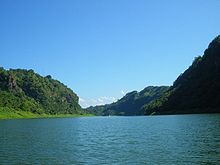
Rangamati(Bengali: রাঙ্গামাটি) is the Administrative Headquarter of Rangamati Hill District in the Chittagong Hill Tracts of Bangladesh. The town is located at 22°37'60N 92°12'0E and has an altitude of 14 metres (49 feet).
From Chittagong a 77 km road amidst green fields and winding hills leads
to Rangamati; which is a wonderful repository of scenic splendours with flora
and fauna of varied descriptions. The township is located on the western bank
of the Kaptai lake. Rangamati is a favourite holiday
destination because of its beautiful landscape, scenic beauty, lake, colourful
indigenus groups (Chakma, Marma etc.), its flora and fauna,
indigenous museum, hanging bridge, homespun textile products, ivory jewellery
and the indigenous men and women who fashion them. For tourists, the
attractions of Rangamati are numerous. Indigenous life, fishing, speed boat
cruising, hiking, bathing or merely enjoying nature as it is.
Wednesday, February 06, 2013
Nilgiri
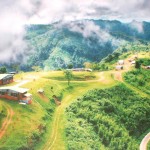

Nil Giri
is the highest hill resort of Bangladesh with amazing natural beauty. This
Resort is located 47 km South-East of Bandarban town on Chimbuk Range at a
height of 2400 feet from sea level. It has a high class residential
accommodation that makes a difference. This beautiful resort in the top
of the mountain maintain by the Bangladesh Army.
You will be amazed when you see that the cloudy sky often kisses the peak of the hill. Gentle breeze was blowing down the hill side and thin clouds were hanging around on their way to casual fly. Dimmed through the clouds, silver moon light was rolling down the folds and slopes. It is Imagine the scene! Clouds are playing with you and you can touch them! This is the most attractive place of Bangladesh for those who love hills and clouds.
How to go:
It is 47 KM away from Bandarban. If you get on a Bus from Dhaka at around 10
o’clock you will reach Bandarban at dawn. For better freedom one can rent a
microbus or car from Dhaka. To save time you can reach Cox’s Bazaar by air for
onwards move to Nilgiri by bus or rent a car. You have to stay at Bandarban
hotel and next day you can move to Nilgiri.
Accommodation:
The accommodation in Nilgiri, in fact, makes its difference. Good hotels are
there at Bandarban city too. Accommodation and food for 3 days will cost near
tk 10000. Conveyance will depend on means you choose from tk 7000 minimum to
maximum tk 11000 if you go by plane to Chittagong. Army man can get special
priority for the lodge and cottages. But if it is not booked by any army and
the lodge may vacant any day, you can reserve it. But it is so scarce
happening. Most of the time Nilgiri remains booked. So try to contact the
authority before three month to stay here. The tent is ready for you for short
notice but you know it is a busy tourist’s spot. So book this before you get
there.
Food Stuff:
Nilgiri is mainly a rest house. It has a clean and healthy restaurant. So don’t
worry about stomach! Rice, beef, mutton are prepared in bamboo without water is
really mouth-watering. Every meal cost is about 200-500 BDT. They can provide
various types of taste food.
Contact
Number of Nilgiri: 01190811322,
01925882338
Subscribe to:
Posts (Atom)






